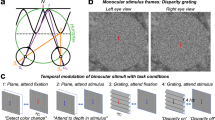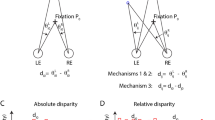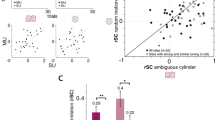Abstract
In perceptual tasks, subjects attempt to rely on their most informative cues. Such strategic choices should be reflected in the types of sensory neurons that are used. We investigated this in a binocular-disparity discrimination task. Using psychophysical reverse-correlation, also known as image classification, we identified the perceptual strategies of two macaques (Macaca mulatta). Correlations between reported disparity signs and disparity noise samples for each trial yielded detection 'filters'. Filter amplitude was greater at near disparities than at far disparities, indicating that the subjects relied more on near disparities. Recordings from both macaques' disparity-selective V2 neurons showed a correlation between neuronal responses and perceptual judgment in near-preferring, but not far-preferring, units, mirroring the psychophysically measured strategy. After one monkey learned to weight near and far disparities equally, activity in its far-preferring neurons correlated with choice. Thus, the pattern of correlations between neuronal activity and perceptual reports indicates how subjects use their neuronal signals.
This is a preview of subscription content, access via your institution
Access options
Subscribe to this journal
Receive 12 print issues and online access
$209.00 per year
only $17.42 per issue
Buy this article
- Purchase on Springer Link
- Instant access to full article PDF
Prices may be subject to local taxes which are calculated during checkout






Similar content being viewed by others
References
Uka, T., Tanabe, S., Watanabe, M. & Fujita, I. Neural correlates of fine depth discrimination in monkey inferior temporal cortex. J. Neurosci. 25, 10796–10802 (2005).
Celebrini, S. & Newsome, W.T. Neuronal and psychophysical sensitivity to motion signals in extrastriate area MST of the macaque monkey. J. Neurosci. 14, 4109–4124 (1994).
Britten, K.H., Newsome, W.T., Shadlen, M.N., Celebrini, S. & Movshon, J.A. A relationship between behavioral choice and the visual responses of neurons in macaque MT. Vis. Neurosci. 13, 87–100 (1996).
Dodd, J.V., Krug, K., Cumming, B.G. & Parker, A.J. Perceptually bistable three-dimensional figures evoke high choice probabilities in cortical area MT. J. Neurosci. 21, 4809–4821 (2001).
Uka, T. & DeAngelis, G.C. Contribution of area MT to stereoscopic depth perception: choice-related response modulations reflect task strategy. Neuron 42, 297–310 (2004).
Parker, A.J. & Newsome, W.T. Sense and the single neuron: probing the physiology of perception. Annu. Rev. Neurosci. 21, 227–277 (1998).
Palmer, C., Cheng, S.Y. & Seidemann, E. Linking neuronal and behavioral performance in a reaction-time visual detection task. J. Neurosci. 27, 8122–8137 (2007).
Parker, A.J., Krug, K. & Cumming, B.G. Neuronal activity and its links with the perception of multi-stable figures. Phil. Trans. R. Soc. Lond. B 357, 1053–1062 (2002).
Purushothaman, G. & Bradley, D.C. Neural population code for fine perceptual decisions in area MT. Nat. Neurosci. 8, 99–106 (2005).
Neri, P. & Levi, D.M. Receptive versus perceptive fields from the reverse-correlation viewpoint. Vision Res. 46, 2465–2474 (2006).
Neri, P., Parker, A.J. & Blakemore, C. Probing the human stereoscopic system with reverse correlation. Nature 401, 695–698 (1999).
Ahumada, A.J. Perceptual classification images from Vernier acuity masked by noise. Perception 26, 18 (1996).
Uka, T. & DeAngelis, G.C. Contribution of middle temporal area to coarse depth discrimination: comparison of neuronal and psychophysical sensitivity. J. Neurosci. 23, 3515–3530 (2003).
Nienborg, H. & Cumming, B.G. Macaque V2 neurons, but not V1 neurons, show choice-related activity. J. Neurosci. 26, 9567–9578 (2006).
Read, J.C. & Cumming, B.G. Ocular dominance predicts neither strength nor class of disparity selectivity with random-dot stimuli in primate V1. J. Neurophysiol. 91, 1271–1281 (2004).
Britten, K.H., Shadlen, M.N., Newsome, W.T. & Movshon, J.A. The analysis of visual motion: a comparison of neuronal and psychophysical performance. J. Neurosci. 12, 4745–4765 (1992).
Shadlen, M.N., Britten, K.H., Newsome, W.T. & Movshon, J.A. A computational analysis of the relationship between neuronal and behavioral responses to visual motion. J. Neurosci. 16, 1486–1510 (1996).
Norcia, A.M. & Tyler, C.W. Temporal frequency limits for stereoscopic apparent motion processes. Vision Res. 24, 395–401 (1984).
Nienborg, H., Bridge, H., Parker, A.J. & Cumming, B.G. Neuronal computation of disparity in V1 limits temporal resolution for detecting disparity modulation. J. Neurosci. 25, 10207–10219 (2005).
Broadbent, D.E. Perception and Communication (Pergamon Press, London, 1958).
Duncan, J. The locus of interference in the perception of simultaneous stimuli. Psychol. Rev. 87, 272–300 (1980).
Deutsch, J.A. & Deutsch, D. Some theoretical considerations. Psychol. Rev. 70, 80–90 (1963).
Treue, S. & Martinez Trujillo, J.C. Feature-based attention influences motion processing gain in macaque visual cortex. Nature 399, 575–579 (1999).
McAdams, C.J. & Reid, R.C. Attention modulates the responses of simple cells in monkey primary visual cortex. J. Neurosci. 25, 11023–11033 (2005).
Haenny, P.E., Maunsell, J.H. & Schiller, P.H. State dependent activity in monkey visual cortex. II. Retinal and extraretinal factors in V4. Exp. Brain Res. 69, 245–259 (1988).
Roelfsema, P.R., Lamme, V.A. & Spekreijse, H. Object-based attention in the primary visual cortex of the macaque monkey. Nature 395, 376–381 (1998).
Luck, S.J., Chelazzi, L., Hillyard, S.A. & Desimone, R. Neural mechanisms of spatial selective attention in areas V1, V2 and V4 of macaque visual cortex. J. Neurophysiol. 77, 24–42 (1997).
Krug, K. A common neuronal code for perceptual processes in visual cortex? Comparing choice and attentional correlates in V5/MT. Phil. Trans. R. Soc. Lond. B 359, 929–941 (2004).
DeAngelis, G.C. & Newsome, W.T. Perceptual “read-out” of conjoined direction and disparity maps in extrastriate area MT. PLoS Biol. 2, E77 (2004).
Gold, J.I. & Shadlen, M.N. Neural computations that underlie decisions about sensory stimuli. Trends Cogn. Sci. 5, 10–16 (2001).
Williams, Z.M., Elfar, J.C., Eskandar, E.N., Toth, L.J. & Assad, J.A. Parietal activity and the perceived direction of ambiguous apparent motion. Nat. Neurosci. 6, 616–623 (2003).
Cook, E.P. & Maunsell, J.H. Dynamics of neuronal responses in macaque MT and VIP during motion detection. Nat. Neurosci. 5, 985–994 (2002).
Maunsell, J.H. & Treue, S. Feature-based attention in visual cortex. Trends Neurosci. 29, 317–322 (2006).
Judge, S.J., Richmond, B.J. & Chu, F.C. Implantation of magnetic search coils for measurement of eye position: an improved method. Vision Res. 20, 535–538 (1980).
Davison, A.C. & Hinkley, D.V. Bootstrap Methods and their Application (Cambridge University Press, 1997).
Acknowledgements
We thank C. Hillman, M. Szarowicz, C. Silver and D. Parker for excellent animal care. This research was supported by the Intramural Research Program of the US National Institutes of Health, National Eye Institute.
Author information
Authors and Affiliations
Contributions
H.N. conducted the experiments and the data analysis and wrote the paper. B.G.C. supervised the project.
Corresponding author
Supplementary information
Supplementary Text and Figures
Supplementary Figures 1–6, Disccusion, Methods and Results (PDF 324 kb)
Rights and permissions
About this article
Cite this article
Nienborg, H., Cumming, B. Psychophysically measured task strategy for disparity discrimination is reflected in V2 neurons. Nat Neurosci 10, 1608–1614 (2007). https://doi.org/10.1038/nn1991
Received:
Accepted:
Published:
Issue Date:
DOI: https://doi.org/10.1038/nn1991
This article is cited by
-
A neural correlate of perceptual segmentation in macaque middle temporal cortical area
Nature Communications (2022)
-
Revealing nonlinear neural decoding by analyzing choices
Nature Communications (2021)
-
Decision-related feedback in visual cortex lacks spatial selectivity
Nature Communications (2021)
-
Feedback determines the structure of correlated variability in primary visual cortex
Nature Neuroscience (2018)
-
The sensory thalamus and cerebral motor cortex are affected concurrently during induction of anesthesia with propofol: a case series with intracranial electroencephalogram recordings
Canadian Journal of Anesthesia/Journal canadien d'anesthésie (2014)



